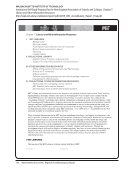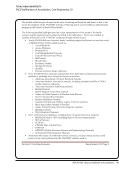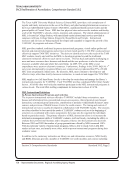SPEC Kit 330: Library Contribution to Accreditation · 129
Massachusetts Institute of Technology
Institutional Self-Study Prepared for the New England Association of Schools and Colleges. Chapter 7:
Library and Other Information Resources
http://web.mit.edu/accreditation/report/pdfs/2009_MIT_Accreditation_Report_Final.pdf
Chapter 7: Library and Other Information Resources
Chapter 7 Page 83
The mission of the MIT Libraries is to create and sustain an intuitive, trusted information
environment that enables learning and the advancement of knowledge at MIT. We are committed
to developing strategies and systems that promote discovery and facilitate worldwide scholarly
communication.
— MIT Libraries mission statement, adopted in 2003
This focus on quality, relevance, and distinction is manifested by a service culture that is constantly
evolving to meet the needs of MIT’s dynamic users. The ongoing goal is to provide immediate,
quantifiable benefits to faculty and students in the Libraries’ domains of responsibility.
Background
The MIT Libraries are centrally funded and managed, but physically dispersed. The system is composed
of five large “divisional” libraries that map roughly to the five schools of MIT two smaller, specialized
branch libraries a community space in the Stata Center academic complex and several small, cost-
recovered services units. In addition, the library system includes the Institute Archives and Special
Collections, which have responsibility for the Institute’s records-management program. Approximately 40
percent of the Libraries’ collections are housed in two off-site storage facilities. For the most part,
resource development, technical services, administration and budgeting, and technology support and
service are centralized. In 2007, the Libraries assumed responsibility for managing Academic Media
Production Services, providing the MIT community with support for video production and
postproduction, online video, technology support for distance education, multimedia, and video
conferencing.
MIT’s physical collections total 2.8 million volumes. They exhibit the current and historical strengths of
the Institute itself, reflecting MIT’s deep intellectual commitment to “science, technology, and other areas
of scholarship that will best serve the nation and the world in the 21st century.” Serials, currently
numbering about 23,000, dominate the collections and collection expenditures. In 1932, the MIT Libraries
joined the Association of Research Libraries, becoming the first technically oriented member.
MIT’s community of faculty, students, and researchers is highly mobile. At a time when no commercial
services were available, the Libraries developed a tool known as Vera to provide a network-accessible,
customized gateway to the licensed electronic databases, books, and full-text journals provided by the
Libraries. Alternative discovery tools are also available through links within Barton, the Libraries’ online
catalog, and via full-text links from Google Scholar. A book- and- image scanning initiative is the latest
addition to the Libraries digital library program. The Libraries’ Technology Operations Group provides
technical support to these digital library services as well as to DSpace@MIT. DSpace reflects MIT’s
tradition of responding to unsolved problems by building our own solutions. With support from Hewlett-
Packard, we created the system as an online digital repository based on an innovative, open-source
program we designed. The MIT research community produces a huge range of electronic documents,
images, data sets, and other files. Through DSpace, MIT is housing over 32,000 items and keeping them
readable, accessible, and searchable, effectively forever. Since its release as open source software in
November 2002, DSpace has achieved widespread adoption at research universities throughout the world.
Leading-edge digital library research using grant and research funding is conducted by the Libraries
Technology Research and Development Group. The unit collaborates extensively with faculty at MIT, the
World Wide Web Consortium, technology companies, and other institutions to develop applications and
address digital library challenges projects include SIMILE,to enhance inter-operability among digital
assets, and FAÇADE, to create preservation strategies for computer-aided architectural design documents.
The Libraries’ endowment is for the most part restricted to the acquisition of materials and directed
largely to the purchase of books and occasionally electronic back files. Recent resource-development
Massachusetts Institute of Technology
Institutional Self-Study Prepared for the New England Association of Schools and Colleges. Chapter 7:
Library and Other Information Resources
http://web.mit.edu/accreditation/report/pdfs/2009_MIT_Accreditation_Report_Final.pdf
Chapter 7: Library and Other Information Resources
Chapter 7 Page 83
The mission of the MIT Libraries is to create and sustain an intuitive, trusted information
environment that enables learning and the advancement of knowledge at MIT. We are committed
to developing strategies and systems that promote discovery and facilitate worldwide scholarly
communication.
— MIT Libraries mission statement, adopted in 2003
This focus on quality, relevance, and distinction is manifested by a service culture that is constantly
evolving to meet the needs of MIT’s dynamic users. The ongoing goal is to provide immediate,
quantifiable benefits to faculty and students in the Libraries’ domains of responsibility.
Background
The MIT Libraries are centrally funded and managed, but physically dispersed. The system is composed
of five large “divisional” libraries that map roughly to the five schools of MIT two smaller, specialized
branch libraries a community space in the Stata Center academic complex and several small, cost-
recovered services units. In addition, the library system includes the Institute Archives and Special
Collections, which have responsibility for the Institute’s records-management program. Approximately 40
percent of the Libraries’ collections are housed in two off-site storage facilities. For the most part,
resource development, technical services, administration and budgeting, and technology support and
service are centralized. In 2007, the Libraries assumed responsibility for managing Academic Media
Production Services, providing the MIT community with support for video production and
postproduction, online video, technology support for distance education, multimedia, and video
conferencing.
MIT’s physical collections total 2.8 million volumes. They exhibit the current and historical strengths of
the Institute itself, reflecting MIT’s deep intellectual commitment to “science, technology, and other areas
of scholarship that will best serve the nation and the world in the 21st century.” Serials, currently
numbering about 23,000, dominate the collections and collection expenditures. In 1932, the MIT Libraries
joined the Association of Research Libraries, becoming the first technically oriented member.
MIT’s community of faculty, students, and researchers is highly mobile. At a time when no commercial
services were available, the Libraries developed a tool known as Vera to provide a network-accessible,
customized gateway to the licensed electronic databases, books, and full-text journals provided by the
Libraries. Alternative discovery tools are also available through links within Barton, the Libraries’ online
catalog, and via full-text links from Google Scholar. A book- and- image scanning initiative is the latest
addition to the Libraries digital library program. The Libraries’ Technology Operations Group provides
technical support to these digital library services as well as to DSpace@MIT. DSpace reflects MIT’s
tradition of responding to unsolved problems by building our own solutions. With support from Hewlett-
Packard, we created the system as an online digital repository based on an innovative, open-source
program we designed. The MIT research community produces a huge range of electronic documents,
images, data sets, and other files. Through DSpace, MIT is housing over 32,000 items and keeping them
readable, accessible, and searchable, effectively forever. Since its release as open source software in
November 2002, DSpace has achieved widespread adoption at research universities throughout the world.
Leading-edge digital library research using grant and research funding is conducted by the Libraries
Technology Research and Development Group. The unit collaborates extensively with faculty at MIT, the
World Wide Web Consortium, technology companies, and other institutions to develop applications and
address digital library challenges projects include SIMILE,to enhance inter-operability among digital
assets, and FAÇADE, to create preservation strategies for computer-aided architectural design documents.
The Libraries’ endowment is for the most part restricted to the acquisition of materials and directed
largely to the purchase of books and occasionally electronic back files. Recent resource-development
























































































































































































